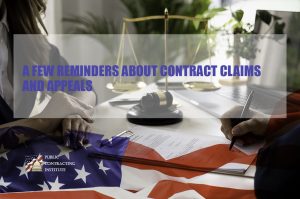A recently considered size decision was remanded to the Area Office of the Small Business Administration (“SBA”) by the Office of Hearings and Appeals (“OHA”) because the Area Office failed to consider all aspects of the ostensible subcontractor rule. Contego Envir’l, LLC, SBA No. SIZ-6054, May 19, 2020.

The ostensible subcontractor rule is found at 13 CFR §121.103(h)(4) and states:
(4) A contractor and its ostensible subcontractor are treated as joint venturers for size determination purposes. An ostensible subcontractor is a subcontractor that is not a similarly situated entity, as that term is defined in § 125.1 of this chapter, and [1] performs primary and vital requirements of a contract, or of an order, or [2] is a subcontractor upon which the prime contractor is unusually reliant. All aspects of the relationship between the prime and subcontractor are considered, including, but not limited to, the terms of the proposal (such as contract management, technical responsibilities, and the percentage of subcontracted work), agreements between the prime and subcontractor (such as bonding assistance or the teaming agreement), and whether the subcontractor is the incumbent contractor and is ineligible to submit a proposal because it exceeds the applicable size standard for that solicitation.
The regulations also state that “[f]or size purposes, a concern must include in its receipts its proportionate share of joint venture receipts, and in its total number of employees its proportionate share of joint venture employees.” 13 CFR 121.203(h)(5).
Contego involved a Department of Veterans Affairs (“VA”) solicitation that sought a contractor to perform construction projects at the Lexington VA Medical Center, using an indefinite quantity, indefinite delivery contract. The solicitation stated that “the contractor shall be required to be located, either by virtue of his main office or a satellite operation base, within an area permitting a maximum of two (2) hour response time” to the Lexington VA Medical Center.”
The awardee, Indigo Blue Construction (Indigo) was protested as not a small business by Contego. In its proposal, Indigo, which is located in Atlanta, Georgia, Indigo partnered with an unnamed subcontractor to perform the work (“Team Indigo Blue”). Indigo’s President was identified as the person who would oversee the contract as Program Manager, but would not be on-site. Other functions and individuals were also identified.
Contego alleged that Indigo was affiliated with its subcontractor, a large business, through common management, joint ventures, ostensible subcontracting and the totality of the circumstances. Indigo denied any affiliation with its subcontractor.
The SBA area office found no affiliation, rejecting all of Contego’s arguments. The Area office found no violation of the ostensible subcontractor rule because, “Indigo will not be unusually reliant upon [subcontractor] to perform the contract.” However, in reviewing the matter, OHA noted that the ostensible subcontractor rule poses a disjunctive test—a concern may violate the rule not only through unusual reliance upon a subcontractor, but also if the subcontractor will perform the “primary and vital” contract requirements. The Area office did not consider the “primary and vital” contract requirements, and therefore the size determination was incomplete in its analysis of the ostensible subcontractor rules. OHA noted that the “primary role of a prime… in a construction project is to superintend, manage and schedule work, including coordinating the work of the subcontractors.[]As a result, on-site management of the contract is of paramount importance in a construction procurement.” OHA also noted that it was not evident that Indigo itself would perform the on site management, so this issue is of extreme importance to the size determination.
OHA therefore granted the appeal and remanded the size determination to the Area Office for further review of the ostensible subcontractor portion of the size protest.
Takeaway. When considering an ostensible subcontractor rule protest, the SBA must consider both possible unusual reliance upon a subcontractor, and also if the subcontractor will perform the “primary and vital” contract requirements. Contractors should consider both parts of the rule as well.
For other helpful suggestions on government contracting, visit:
Richard D. Lieberman’s FAR Consulting & Training at https://www.richarddlieberman.com/, and Mistakes in Government Contracting at https://richarddlieberman.wixsite.com/mistakes.
